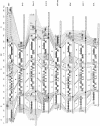Evolutionary aspects of oncogenic herpesviruses
- PMID: 11091846
- PMCID: PMC1186975
- DOI: 10.1136/mp.53.5.222
Evolutionary aspects of oncogenic herpesviruses
Abstract
Several of the gamma-herpesviruses are known to have cellular transforming and oncogenic properties. The genomes of eight distinct gamma-herpesviruses have been sequenced, and the resulting database of information has enabled the identification of genetic similarities and differences between evolutionarily closely related and distant viruses of the subfamily and between the gamma-herpesviruses and other members of the herpesvirus family. The recognition of coincident loci of genetic divergence between individual gamma-herpesviruses and the identification of novel genes and cellular gene homologues in these genomic regions has delineated a subset of genes that are likely to contribute to the unique biological properties of these viruses. These genes, together with gamma-herpesvirus conserved genes not found in viruses outside the family, might be responsible for virus specific pathogenicity and pathogenic effects, such as viral associated neoplasia, characteristic of the subfamily. The presence of the gamma-herpesvirus major divergent genomic loci and the apparent increased mutational frequencies of homologous genes (where they occur) within these regions, indicates that these loci possess particular features that drive genetic divergence. Whatever the mechanisms underlying this phenomenon, it potentially provides the basis for the relatively rapid adaptation and evolution of gamma-herpesviruses and the diversity of biological and pathogenic properties.
Figures

Similar articles
-
Impacts of Genome-Wide Analyses on Our Understanding of Human Herpesvirus Diversity and Evolution.J Virol. 2017 Dec 14;92(1):e00908-17. doi: 10.1128/JVI.00908-17. Print 2018 Jan 1. J Virol. 2017. PMID: 29046445 Free PMC article. Review.
-
Equine herpesviruses 2 and 5 are gamma-herpesviruses.Virology. 1993 Aug;195(2):492-9. doi: 10.1006/viro.1993.1400. Virology. 1993. PMID: 8337826
-
The role of DNA repair in herpesvirus pathogenesis.Genomics. 2014 Oct;104(4):287-94. doi: 10.1016/j.ygeno.2014.08.005. Epub 2014 Aug 27. Genomics. 2014. PMID: 25173572
-
Molecular evolution of the gamma-Herpesvirinae.Philos Trans R Soc Lond B Biol Sci. 2001 Apr 29;356(1408):421-35. doi: 10.1098/rstb.2000.0775. Philos Trans R Soc Lond B Biol Sci. 2001. PMID: 11313003 Free PMC article. Review.
-
Phylogenetic analysis, genome evolution and the rate of gene gain in the Herpesviridae.Mol Phylogenet Evol. 2007 Jun;43(3):1066-75. doi: 10.1016/j.ympev.2006.11.019. Epub 2006 Nov 29. Mol Phylogenet Evol. 2007. PMID: 17196839
Cited by
-
Gamma herpesviruses: pathogenesis of infection and cell signaling.Folia Microbiol (Praha). 2003;48(3):291-318. doi: 10.1007/BF02931360. Folia Microbiol (Praha). 2003. PMID: 12879740 Review.
-
A novel strain of cynomolgus macaque cytomegalovirus: implications for host-virus co-evolution.BMC Genomics. 2016 Apr 5;17:277. doi: 10.1186/s12864-016-2588-3. BMC Genomics. 2016. PMID: 27044312 Free PMC article.
-
The Current State of Vaccine Development for Ocular HSV-1 Infection.Expert Rev Ophthalmol. 2015 Apr 1;10(2):113-126. doi: 10.1586/17469899.2015.1004315. Expert Rev Ophthalmol. 2015. PMID: 25983856 Free PMC article.
-
Prevalence, Geographic Distribution, Risk Factors and Co-Infections of Feline Gammaherpesvirus Infections in Domestic Cats in Switzerland.Viruses. 2019 Aug 6;11(8):721. doi: 10.3390/v11080721. Viruses. 2019. PMID: 31390829 Free PMC article.
-
Themed issue: the biology and pathology of the Epstein-Barr virus.Mol Pathol. 2000 Oct;53(5):219-21. doi: 10.1136/mp.53.5.219. Mol Pathol. 2000. PMID: 11091845 Free PMC article. No abstract available.
References
-
- Gompels UA, Nicholas J, Lawrence G, et al. The DNA sequence of human herpesvirus-6: structure, coding content, and genome evolution. Virology 1995;209:29–51. - PubMed
-
- Bublot M, Lomonte P, Lequarre A-S, et al. Genetic relationships between bovine herpesvirus 4 and gammaherpesviruses Epstein-Barr virus and herpesvirus saimiri. Virology 1992;190:654–65. - PubMed
-
- Kouzarides T, Bankier AT, Satchwell SC, et al. Large-scale rearrangement of homologous regions in the genomes of HCMV and EBV. Virology 1987;157:387–413. - PubMed
-
- McGeoch DJ. The genomes of human herpesviruses: contents, relationships, and evolution. Annu Rev Microbiol 1989;43:235–65. - PubMed
Publication types
MeSH terms
Substances
LinkOut - more resources
Full Text Sources
Other Literature Sources
